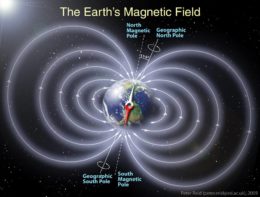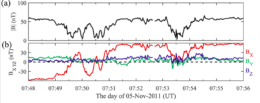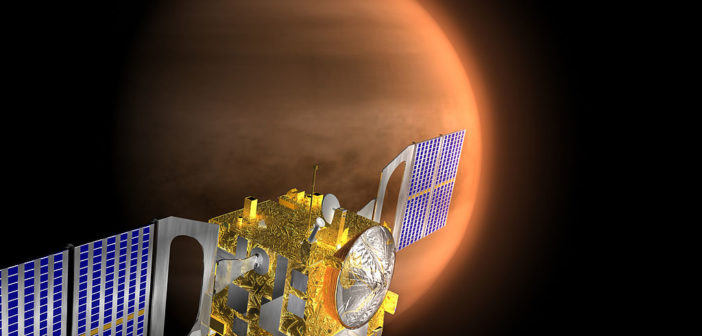What happens to Venus when an enormous solar eruption slams into the planet? In 2011, the Venus Express spacecraft was on site to find out!
Benefits of a Field

Schematic illustration of the Earth’s global magnetic field. Venus does not have an intrinsic field. [NASA / Peter Reid / TheUniversity of Edinburgh]
But our sister planet, Venus, is less fortunate: though similar to Earth in many ways, Venus lacks its own global magnetic field to protect it from the Sun’s onslaught.
What happens to this clouded planet when the Sun sends an enormous interplanetary coronal mass ejection its way?

The interaction of Venus with the magnetized solar wind produces an induced magnetosphere. [Ruslik0]
With a Little Help from the Sun
Venus has a trick up its sleeve: though it doesn’t carry its own magnetic field, it boasts an induced magnetosphere.
As extreme ultraviolet radiation from the Sun lights up Venus’s dayside, it ionizes the planet’s upper atmosphere, forming a plasma known as the ionosphere. When the solar wind — which carries the Sun’s magnetic field with it — encounters Venus, the thermal pressure of the ionosphere pushes back against the magnetic pressure of the solar wind, causing the field lines to drape around Venus and remain supported there.
This induced magnetosphere has a bow shock on the Sun side and a long, trailing magnetotail on the anti-Sun side. The pile-up of magnetic field between the magnetosphere and Venus’s ionosphere — the magnetic barrier — prevents the solar-wind plasma from penetrating deeper down into Venus’s atmosphere.
Front-Row Seats to Action
So Venus isn’t unprotected — but how well does this shield hold up in the face of powerful solar storms? In 2011, we had a orbiter ready to watch the stormy drama up close: the Venus Express spacecraft.
Venus Express, launched in 2005, orbited around Venus’s poles and studied the global space environment around the planet. On 5 November, 2011, an extremely strong interplanetary coronal mass ejection hit Venus while the spacecraft was in orbit — and now, in a publication led by Qi Xu (Macau University of Science and Technology, China), a team of scientists has detailed what the spacecraft learned.
Not Unflappable

The magnetic field strength (top) and direction (bottom) measured by the Venus Express reveal the rapid flapping motion of the plasma sheet in the magnetotail in response to the interplanetary coronal mass ejection. The red line shows that the Bx component of the magnetic field changed direction 5 times within 1.5 minutes (7:49:30–7:51:00)! [Adapted from Xu et al. 2019]
Based on their analysis, Xu and collaborators expect that interplanetary coronal mass ejections like this one substantially increase the rate of Venus’s atmospheric loss, violently driving ions from the planet’s gravitational grasp.
We still have a lot to learn about about how our sister planet reacts when solar storms strike, but these observations have shed new light on the dramatic struggle.
Citation
“Observations of the Venus Dramatic Response to an Extremely Strong Interplanetary Coronal Mass Ejection,” Qi Xu et al 2019 ApJ 876 84. doi:10.3847/1538-4357/ab14e1

3 Comments
Pingback: Cómo reacciona Venus cuando el Sol golpea – Observatori Astronòmic
Pingback: Julio 2019 – Observatori Astronòmic
Pingback: Cómo reacciona Venus cuando el Sol golpea « SEDA / LIADA - RedLIADA - Cursos LIADA - Cielo del Mes - Fenómenos Astronómicos - RELEA